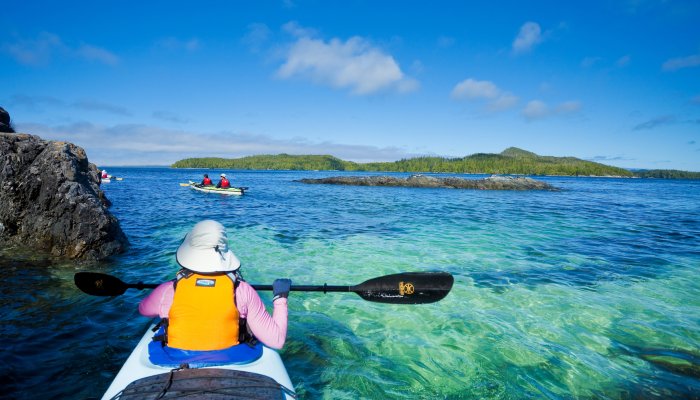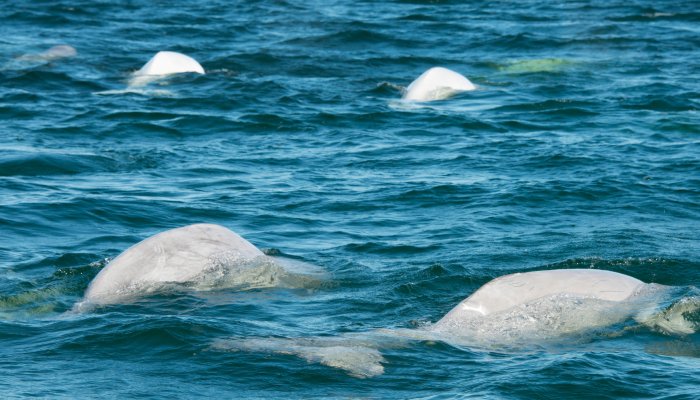Thar she blows? No, thar she sounds. Belugas, the vociferous canaries of the sea, are way more likely to make waves with their underwater operettas than by showing you their tail fin. In the cold, dark waters of the subarctic St. Lawrence River and the Arctic—where the ice grows thick and a palpable stillness settles over the land—belugas croon to one another in a cacophony of whale song.
Of course, whales in general are musicians. The complex arias sung by humpbacks, the resonant percussion of Pacific grays, the throbbing drumbeat of blue whales that travels for miles, and the beluga’s rhythmic clicking reminiscent of Spanish castanets all echo below the surface. The elaborate, subaqueous web of whale song is anything but arbitrary. Whales rhyme in ABA patterns, incorporate phrase lengths, and pull from the bricolage of song structures and themes they’ve acquired throughout their years. Whales don’t simply sing; they compose.
With their musical vocabulary comprised of trills, chirps, clicks, mews, high-pitched whistles, bell-like tones, and more, beluga whales have a grab-bag full of sounds to choose from in their compositions. As the sociable belugas travel in gams, or herds, they communicate constantly with one another. Unlike some other whales, however, the gaggle of belugas can be heard clearly above the water—thus earning them the epithet of “canaries of the sea” by early whalers.
Recent research suggests that belugas might have more in common with parrots than canaries, however. NOC (pronounced no-see), a beluga held at San Diego’s National Marine Mammal Foundation and part of a Navy “Cold Ops” team, has gone down in history as the first beluga whale known to “speak” to his human companions. Although NOC was speaking to his trainers in the ‘80s, it wasn’t until 2012 that Current Biology released the findings of Sam Ridgeway, NOC’s trainer, concerning NOC’s speechlike chatter in an article titled “Spontaneous Human Speech Mimicry by a Cetacean.” From there, NOC’s atonal garbles went global.
According to the trainers, NOC’s voice was discovered accidentally. People thought they had heard the hum of people conversing just out of hearing range. Mumbles one could almost, but not quite, make out. A diver swimming alongside the beluga in his pen surfaced convinced someone was telling him to get “out” repeatedly—only to find no one had been speaking to him. Only after several “conversations” were heard was NOC discovered to be the unlikely source.
It wasn’t easy for NOC to talk. In order to create human-like sounds at their different pitch, NOC needed to increase the pressure of his nasal tract as well as inflate the vestibular sac near his blowhole to levels outside of the beluga’s normal ranges. He also varied his rhythm to match patterns of human speech. For his efforts, NOC’s “melon”—the prominent, bulbous dome on the head of belugas—was distended far more than normal.
Ridgeway’s findings were significant in several ways. NOC’s unprompted mimicry suggests the beluga had a remarkable desire to contact and interface with his human companions. Furthermore, the research reveals how an animal can fashion new sounds, rhythms, and frequencies outside of their usual repertoire simply by listening. That being said, it remains unclear if NOC was attempting to communicate or if he was simply dabbling in the art of vocal imitation—a favorite learning technique of humpback whales as well as dolphins.
While NOC’s verbal skills may not have moved up to the rank of “conversation,” he had a spectacular singing voice worthy of the beluga chorus. His muffled song is a toss-up between Dory’s estimation of “speaking whale” in Finding Nemo and the Muppet’s Swedish Chef singing “Meatballs.” And if NOC burst into song spontaneously, maybe belugas can move up to “Bohemian Rhapsody” with training!
Want to see the belugas and hear them sing for yourself? You don't have to head all the way to the Arctic, where most belugas live. A special population of belugas live in Quebec's Saguenay Fjord, just a handful of hours north of the U.S.-Canadian border. Hop on our Qeubec kayak tour, and see the belugas in action!



